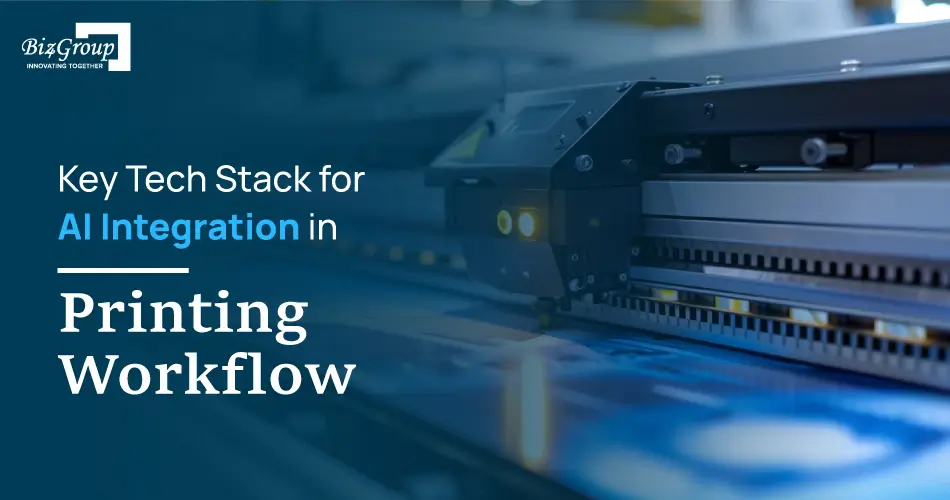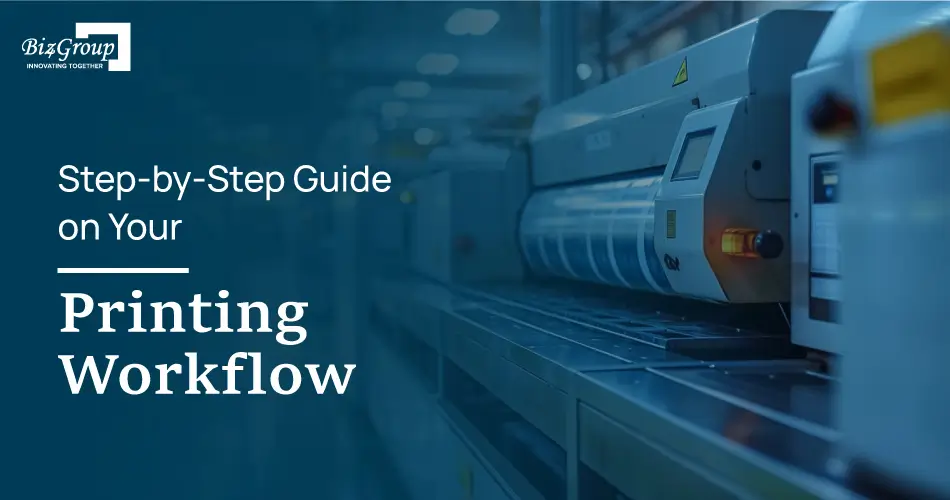Basic AI Chatbot Pricing: A simple chatbot that can answer questions about a product or service might cost around $10,000 to develop.
Read More
In today's rapidly evolving printing industry, integrating AI with printing processes has become a game-changer. The role of AI in printing, including 3D printing, is reshaping traditional workflows, enhancing efficiency, and elevating output quality. As we delve into the topic, we'll explore how AI technologies are revolutionizing various stages of the printing process. From prepress design to post-press finishing, the adaptive capabilities of AI are streamlining operations and optimizing outcomes. Join us as we uncover the transformative potential of AI in the printing industry and navigate the future of AI-enabled printing solutions.
Integrating AI into your printing workflow brings numerous benefits but also presents challenges. Data security and privacy, training hurdles, and ethical concerns are critical considerations. As AI becomes more prevalent in the printing industry, addressing these challenges is essential for successful AI integration with 3D printing and traditional printing processes.
Integrating AI into your printing workflow poses multiple challenges. Firstly, data security and privacy concerns arise due to the sensitive nature of print-related data.
Secondly, training and adoption challenges may hinder the smooth implementation of AI technologies, requiring significant investment in staff training and organizational restructuring.
Lastly, ethical considerations in AI implementation, such as bias in algorithms or job displacement concerns, must be addressed to ensure responsible AI integration with the printing industry.
When considering the integration of AI with the printing industry, various factors are under consideration. Firstly, robust data security measures are in place to protect sensitive print-related data.
Secondly, addressing training and adoption challenges by providing comprehensive training programs and fostering a culture of AI acceptance within the organization.
Lastly, prioritizing ethical considerations in AI implementation to mitigate biases and ensure fair and responsible use of AI technologies in 3D printing and other printing processes. We now know the potential challenges and considerations; it is time to learn about the process of integrating AI into your workflow.

Integrating AI into the printing industry represents a significant leap forward in optimizing workflows and enhancing productivity. By seamlessly integrating AI technologies into printing processes, businesses can discover multiple benefits, ranging from improved efficiency to enhanced quality control. For one of our clients, we used a few of the technologies mentioned in the article and delivered the product with efficacy. The client stated, “I'm impressed with the consistent delivery excellence of Biz4Group. Their collaborative spirit fosters groundbreaking creations and elevated businesses.”
| Technology | Description |
|---|---|
| Machine Learning (ML) | - |
| Supervised learning | Used for tasks like image recognition and natural language processing, facilitating defect detection and content creation. |
| Unsupervised learning | Applied for anomaly detection and clustering, aiding in identifying irregular patterns and grouping customers. |
| Reinforcement learning | Less common but useful for optimizing printing press settings or 3D printing processes, enhancing efficiency. |
| Deep Learning | - |
| Convolutional Neural Networks (CNNs) | Effective for image and video analysis, suitable for defect detection, quality control, and image personalization. |
| Generative Adversarial Networks (GANs) | Employed for generating new design layouts or personalized content, fostering creativity and customization. |
| Other technologies | - |
| Computer vision | Crucial for tasks like image analysis and object recognition, vital for various printing applications. |
| Natural language processing (NLP) | Used for understanding and generating text, enabling content creation, personalization, and marketing automation. |
| Big data analytics | Analyzes large datasets to identify trends, predict problems, and optimize processes in printing. |
| Cloud computing | Offers scalability and accessibility for AI tools, enhancing flexibility and efficiency in printing workflows. |
| Programming languages and frameworks | - |
| Python | Popular for AI development with extensive libraries like TensorFlow, PyTorch, and scikit-learn. |
| Java | Commonly used in enterprise-level AI applications, providing robust solutions for printing workflows. |
| R | Suitable for statistical analysis and data visualization, aiding in analyzing printing data effectively. |
Now, it's time to get into the detailed tech stack to understand the technology used to integrate AI in your workflow and a brief about their functioning. Remember, these suggested technologies are merely for representation purposes only. As an AI development company, we have hands-on experience of various technologies depending on project requirements.

Integrating AI into the printing industry offers significant potential for streamlining processes, enhancing productivity, and improving outcomes. However, before embarking on this journey, it's crucial to focus on the right tech stack.
| Technology | Description |
|---|---|
| OpenAI API | A framework for content creation, particularly adept at generating creative text formats and assisting with tasks like blog intros and outros. |
| LaMDA | A content creation framework designed to generate natural language responses, suitable for various applications, including blog intros and outros. |
| GPT-3 | An advanced language model known for generating human-like text, beneficial for creating creative and engaging content for blogs and other formats. |
| DeepAI | An image editing tool leveraging deep learning techniques to enhance visuals and create graphics, improving the overall quality of printed materials. |
| RunwayML | An image editing platform that utilizes machine learning algorithms to generate and manipulate images, enhancing their visual appeal for print materials. |
| Google Data Studio | A data analysis tool enabling visualization of printing industry trends, providing insights into market dynamics and performance metrics. |
| Tableau | A data visualization platform used for analyzing and interpreting printing data, facilitating informed decision-making and strategic planning. |
| Surfer SEO | An SEO optimization tool focused on improving blog content for search engines, enhancing visibility and driving organic traffic to printing-related content. |
| Clearscope | An SEO optimization platform that helps refine blog content to improve search engine rankings, ensuring that printing-related articles reach a wider audience. |
| Adobe Sensei | A design and prepress tool offering functionalities like font matching and layout optimization, ensuring high-quality and visually appealing print designs. |
| Autodesk Within Design | A software for packaging design, facilitating the creation of innovative and visually appealing packaging solutions tailored to specific printing requirements. |
| Tilia Phoenix | An imposition software used in prepress operations to optimize layouts and arrange printing plates efficiently, improving workflow and reducing production costs. |
| Heidelberg Prinect Production Manager | A printing and production management tool, streamlining production processes and enhancing efficiency in the printing workflow. |
| Landa MIS LMIS.ai | A management information system (MIS) designed for printing companies, assisting with production planning, resource allocation, and workflow optimization. |
| PressUp AI | A quality control tool for the printing industry, utilizing AI algorithms to detect defects and ensure the quality and accuracy of printed materials. |
| Scodix Personalization Suite | A marketing and personalization tool enabling variable data printing, allowing for customized and personalized printed materials tailored to individual preferences. |
| Movable Ink | An interactive marketing platform that enhances printed materials with personalized content, improving engagement and driving customer interactions. |
| Xeikon X-800 | A digital press designed for personalized printing, offering advanced capabilities for creating customized and tailored printed materials. |
| 3DEXPERIENCE Dassault Systèmes | A technology for 3D printing design, providing tools and solutions for designing and prototyping 3D-printed objects and products. |
| Stratasys Sigmascape | A platform for 3D printing optimization, assisting with the optimization of printing parameters and settings to improve the quality and efficiency of 3D prints. |
| Prusa Print | A tool for 3D printing error correction, enabling the identification and rectification of errors in 3D-printed objects, ensuring high-quality print outcomes. |
| Supervised learning | A machine learning technique used for tasks like defect detection and content creation, leveraging labeled data to train predictive models and make accurate predictions. |
| Unsupervised learning | A machine learning approach suitable for anomaly detection and customer segmentation, extracting patterns and insights from unlabeled data without predefined labels. |
| CNNs | Convolutional Neural Networks, utilized for image and video analysis, enabling tasks like defect detection and quality control in printed materials. |
| GANs | Generative Adversarial Networks, used for creative content generation, such as creating new design layouts and personalized content for printing applications. |
| Computer vision | Technology used for image analysis and object recognition, supporting tasks like defect detection and quality control in printed materials. |
| Natural language processing | Technology for text understanding and generation, assisting with content creation and personalization of printed materials through automated text processing. |
| Big data analytics | Analytical techniques applied to printing data for identifying trends, patterns, and optimization opportunities, enhancing decision-making and workflow efficiency. |
| Cloud computing | A scalable and accessible infrastructure for deploying AI tools and platforms, enabling printing companies to leverage advanced AI capabilities with ease. |

Integrating AI with the printing industry has become increasingly imperative. Leveraging AI technologies can streamline workflows, enhance productivity, and unlock new opportunities for innovation. In this section, we'll explore the key tech stack required to integrate AI into your printing workflow.
This layer provides the hardware infrastructure environment, integrating all Infrastructure as a Service (IaaS) components, accelerators like GPUs, TPUs, and FPGAs, and additional services for monitoring, clustering, and billing tools.
Platform as a Service (PaaS) components, MLOps, and Intelligent Engagement Platform (IEP) integrated to manage the complete AI application lifecycle, including model building, evaluation, and monitoring for continuous integration, delivery, and testing.
This layer consists of AI-related frameworks to accelerate the development and deployment of AI applications, including tensor computing, automatic differentiation systems, and pre-built AI algorithm libraries and models.
It provides a repository of well-defined AI algorithms, including supervised, unsupervised, and reinforcement learning algorithms, to facilitate problem-solving and decision-making tasks.
This layer integrates Data as a Service (DaaS) and DataOps platforms to manage the end-to-end data lifecycle, including data preprocessing, feature engineering, and handling batched and real-time data access.
Here, ready-to-use, general-purpose APIs for AI-enabled services such as image processing and natural language processing (NLP) are provided, allowing seamless integration with existing IT applications and enterprise systems.
This layer offers AI-enabled solutions tailored to specific business domains, allowing for delivering broad AI capabilities in different companies or industry domains.
This proposed AI tech-stack model serves as a conceptual framework, facilitating vendor interoperability and minimizing the threat of vendor lock-in. Vendors can develop products and services at specific layers, ensuring consistency and compatibility across the AI ecosystem.

Integrating AI into the printing industry has revolutionized printing workflows, enhancing efficiency and quality. This step-by-step guide outlines the process from prepress preparation to delivery, highlighting the role of AI in optimizing each stage. Let's delve into each step to understand how AI integration is reshaping the printing industry.
Prepping digital files is essential for seamless printing. AI-powered software can analyze files, ensure correct formats, detect errors, and optimize elements like images and fonts for superior print quality.
With AI integration, file submission becomes streamlined, leveraging automated systems for online submissions or cloud-based platforms for seamless collaboration between clients and printing providers.
AI algorithms perform prepress checks, swiftly identifying formatting issues and automatically correcting them. It ensures files are print-ready, reducing manual intervention and potential errors.
AI enables advanced proofing capabilities, offering interactive digital proofs that simulate final print results, allowing stakeholders to review and approve designs remotely with precision and accuracy.
AI streamlines the approval process by providing real-time feedback on proofs, facilitating faster decision-making, and minimizing delays in production schedules
AI-driven printing processes optimize production efficiency, dynamically adjusting settings based on job requirements and monitoring print quality in real-time to ensure consistent results.
AI algorithms optimize finishing processes, automating tasks like cutting, folding, and binding to streamline workflows and reduce production times.
AI-powered inspection systems ensure stringent quality control, detecting defects and deviations from specifications with unmatched accuracy, minimizing waste and rework.

AI streamlines packaging and shipping processes, optimizing logistics and ensuring timely delivery of printed materials to customers or distribution center.
With AI integration, delivery, and distribution become more efficient, leveraging predictive analytics to optimize routes and schedules, minimizing transit times and costs.
AI analytics gather feedback from stakeholders, analyzing data to identify areas for improvement and refine printing workflows for enhanced efficiency and customer satisfaction.
By integrating AI into printing workflows, businesses can achieve unparalleled efficiency, quality, and customer satisfaction, driving success in the rapidly evolving printing industry.
In conclusion, the integration of AI with the printing industry marks a significant leap forward in workflow optimization. From prepress design to post-press finishing, AI streamlines each stage, enhancing efficiency and quality. Embracing digital integration and automation is paramount for staying competitive in today's fast-paced market. As we look ahead, future trends indicate even greater advancements in printing workflow technology, driven by AI's adaptability and innovation. By embracing the potential of AI integration with printing, businesses can discover new levels of productivity and creativity in their operations, ushering in a new era of printing excellence.
with Biz4Group today!
Our website require some cookies to function properly. Read our privacy policy to know more.